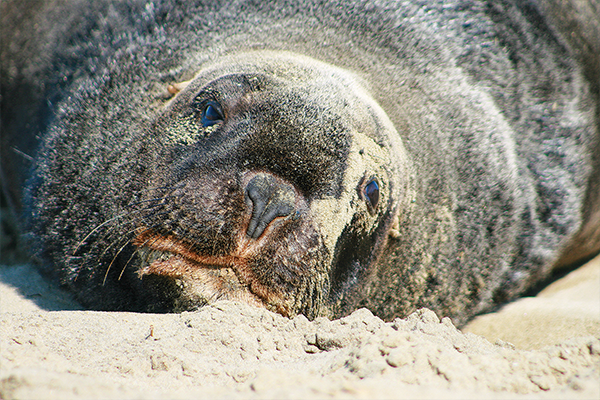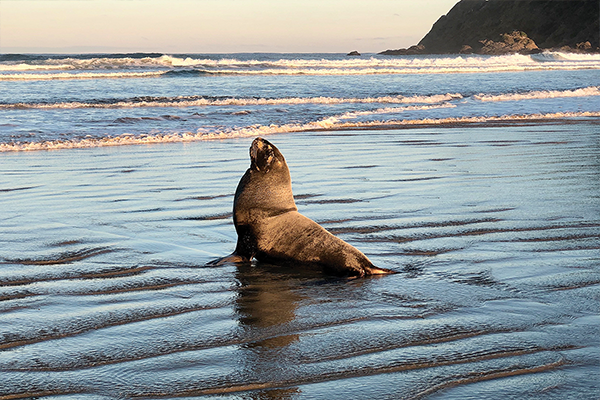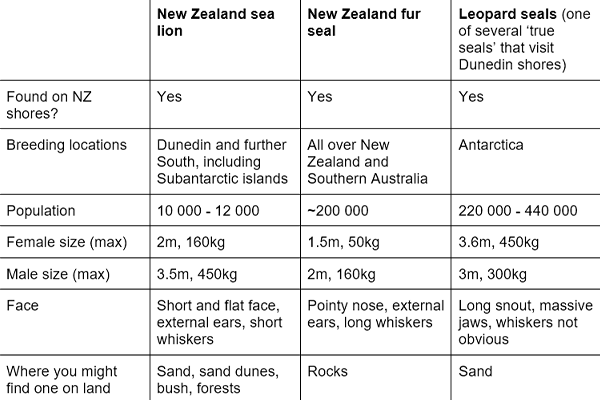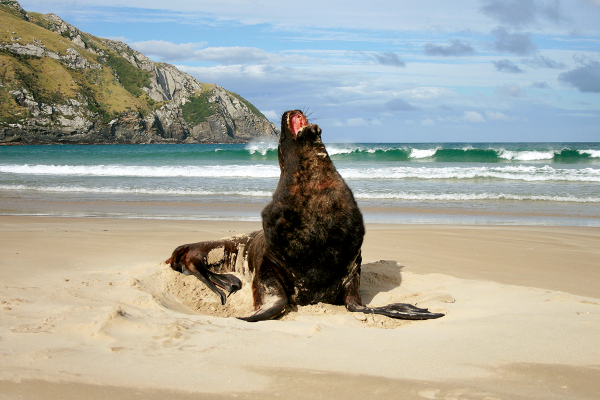New Zealand sea lions are the rarest sea lions on the planet today. But after being wiped out on the mainland, rāpoka are making a dramatic comeback to Aotearoa - and Ōtepoti Dunedin is one of the best places to enjoy their company.
Often known as rāpoka in te reo Māori (with varying words for the males and females
individually) the New Zealand sea lion is one of our largest and most imposing native animals. Most older Otago alumni had affordable costs of living, thriving student pubs, and the ability to largely avoid the climate crisis. But one thing they didn’t have was rare, playful, blubbery half-tonne marine mammals on their doorstep.
Bruce Robertson teaches conservation genomics and wildlife management at the Department of Zoology. He is not a rāpoka. He is, however, a science advisor to the New Zealand Sea Lion Trust (NZSLT) and he says that according to genetic information, there were once around 60-100,000 sea lions roaming our shores. They bred all across the mainland, and there are even “reports of pups from skeletal remains in Cape Reinga.” While, according to Robertson, no one is “quite sure who finished them off”, the arrival of Polynesians to Aotearoa and later sealers in the late 1700s spelled the end for sea lions on the main islands. By the early 1800s, sea lions on our coastlines were completely wiped out, leaving only the hardy populations on our subantarctic Auckland and Campbell Islands to pass the genetic torch.

Life wasn’t peachy even for those left in the isolated South. Commercial sealing focused on hunting fur seals for their luxurious pelts, which were sent back to Europe for 1800s Instagram influencers to wear in their 1800s Instagram stories. Sealers wouldn’t pass up an opportunity to kill a sea lion (or “hair seal” as they were called then) to use for lamp oil, either. More recently, in the late 90s, sea lions were being caught in squid trawling nets at an alarming rate. While Sea Lion Exclusion Devices (SLEDs) have since been introduced, populations have continued to decline.
Robertson, DOC ranger Jim Fyfe, and NZSLT co-chair Bryony all point to bycatch and resource competition from fisheries as still seriously contributing to the decline of sea lions in our subantarctic islands. They are also being affected by disease and environmental conditions. The most recent annual count on the Auckland Islands, released a couple of weeks ago, showed a worrying 30% drop in pups born since just last summer. But while pup birth rates are down in the subantarctics, they’re up on the mainland for the first time since the late 18th century.
A few decades ago, a few intrepid sea lion mothers took matters into their own hands - or flippers, or something. In 1993, a sea lion now known as Mum gave birth to a pup on the Dunedin coast. While the shores of the South Island had been visited by many wandering males before, this was the first time in over 150 years that pups had actually been born on the mainland. Sea lions, like late-night students, have a strong habit of wandering back to where they started. For sea lions, this means their birthplace; since Mum gave birth in Dunedin, her pups should keep coming back here to give birth, too.
“We’ve now got probably five generations now of pups in that family line and around 25 breeding females…the story of Mum and her colonisation of the Otago peninsula is still a strong and steady one,” as Jim Fyfe put it. “All pups born along the Dunedin coast today are believed to be descended directly from Mum and her offspring,” said Bryony. There are now also breeding females in a number of locations further down the Otago and Southland coasts.
Jim Fyfe reckons that “for the sea lions to be expanding their range is bloody good news — all their eggs aren’t in one basket and they’ve got a better chance of surviving somewhere.” He also says that it is an “amazing opportunity for people in Dunedin to see these impressive and very intelligent animals with a wide range of interesting behaviours” and hopes we can “start to enjoy them as sentient and intelligent neighbours.”
Sea lions have not returned to Dunedin without challenges. They love the coast just as much as humans do, but in the time that they’ve been away “we’ve built roads and settlements right on the coastline,” said Bryony. He added that the NZSLT “frequently see sea lions crossing coastal roads in search of a nice place to rest. Or, in the case of breeding females, a quiet place to pop away from the boisterous male sea lions.” Fyfe and the local teams at DOC and NZSLT are constantly working to mitigate challenges posed by the “limitation of habitat availability around the city”, a plight common to renters and sea lions alike. This means managing roads, educating dog owners, and trying to “keep tourists from wandering up and disturbing them.” In 2003, the New Zealand Sea Lion Trust was founded “to provide protection to, education about, and support research on” the endangered taonga. Bryony says their role is to “advocate for sea lions, educate the community about sea lions, support scientific research, and assist the Department of Conservation in monitoring the local breeding population.”
Jim Fyfe affirmed that people should be wary of sea lions on any coastal road around Dunedin, “especially around breeding time, from January until around May.” In June last year, a pup was killed in a hit-and-run on the Otago Peninsula, not for the first time.
Dogs can also be a threat. Unlike other sea lions and seals, female New Zealand sea lions are not restricted just to the beach; they can wander kilometres inland while they raise their pup, putting them at risk of mixing with canines where owners might not be expecting. Fyfe spoke of a very recent incident where “we had a dog the other day pick up a sea lion pup and throw it around.” He said that dog owners “need to be aware of sea lions”, and what their pets can do to them, even though “everyone thinks their dog wouldn’t.”
Surfers can also be surprised by a sea lion, who Fyfe warns to ignore them and not engage. “It’s not because they’re aggressive, it’s just their way of play is very boisterous and energetic … if you start interacting they’ll want to play - which is not advisable.” For beachgoers who come across sea lions, the advice is similar. “Take the time to enjoy them sharing our beaches,” Bryony suggests, but keep your distance and don’t harass them. If a sea lion approaches you, walk away slowly. Despite these challenges, Bryony describes the work of the NZSLT as “awesome”, especially seeing “the way the Dunedin community has embraced the return of sea lions to mainland New Zealand and they have become a part of our beach culture.”
Otago students have been involved in the research and conservation of our sea lions since at least the 1990s, and continue to play a role today. Bryony is a current PhD student, and there are a number of other students, recent graduates, researchers, and professors from Otago Uni on the NZSLT committee. Local students also regularly assist with beach advocacy volunteering, like Sian Mair, who describes sea lions as “cheeky, playful, and placid”. In the Department of Zoology, there are numerous ongoing projects aimed at finding out more about New Zealand sea lions, which will hopefully aid in their conservation. Professor Robertson is involved in research looking at the genetic basis of mortality, to “see if there is anything genetic that makes pups more susceptible to mortality from disease”. Nia-joelle Weinzweig is a Master’s student studying the parasites present in “faecal samples from sea lions around Dunedin and the Otago peninsula”. Nia is “interested in the connections between human, domestic species, ecosystem, and wildlife health”, and hopes that her research will highlight any parasites of concern as well as providing a baseline to monitor parasites in sea lions in the future.
Nia says she initially found sea lions “quite intimidating” but in time she learnt to understand their behaviour, including all of their little quirks. Her favourite finding is that “the large males really enjoy their comforts and will seek out big piles of kelp on the beach as a pillow for their long nap”. Nia’s research also means she can’t escape working with lots of sea lion poo. “It smells about as bad as you'd imagine! It's a brave person who's willing to share lab space with me in the Department of Zoology!”

Our local Dunedin sea lion population is “currently at around 21 pups a year” according to Jim Fyfe. An official breeding colony requires 35 pups to be born for five years in a row and, while Fyfe and Robertson both believe those numbers are at least a decade away, they are confident we are on track for an official Dunedin sea lion breeding colony.
With sea lions continuing to increase around the city and peninsula, what does the future look like for humans and sea lions on local beaches? “The world I see is one where people are educated to the point that they know what to do. I don’t think there is scope with sea lions to say ‘this is your area’ and ‘keep out of this area’,” reckons Jim Fyfe. “We have to have an element of understanding so that people do the right thing. That means not being scared of them, and knowing enough to not be afraid of them”.
Bryony is also hopeful for our local sea lions. “Although sea lions are an endangered species and their populations on some of the subantarctic islands are in decline, it’s awesome to see the increasing population of our local animals” she says. “Having previously been involved in species that are in pretty bad shape, the natural recolonisation by sea lions to the mainland of New Zealand is pretty special and we can all be a part of the success story by sharing our coastal environments.”

**All photos featured were taken with a zoom lens at a safe distance away. The wildlife code advises keeping at least 20m away from sea lions. Photos taken by Sian Mair



